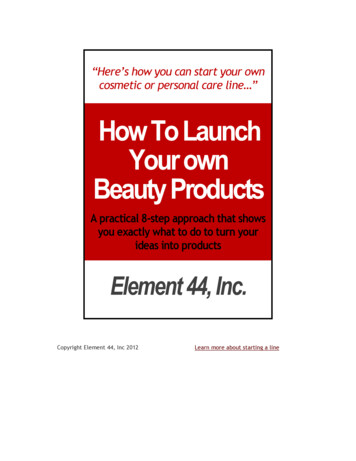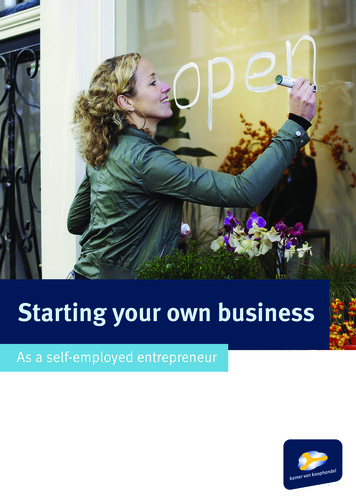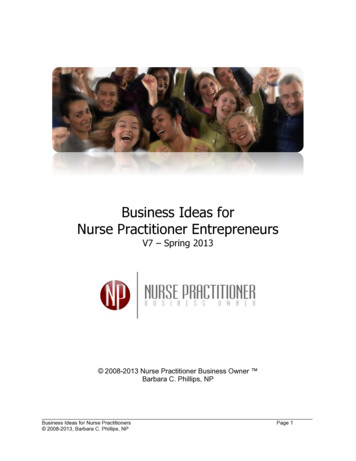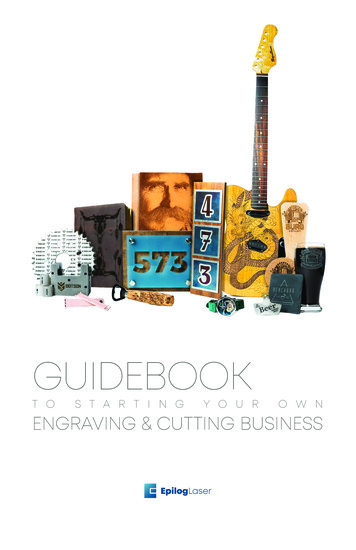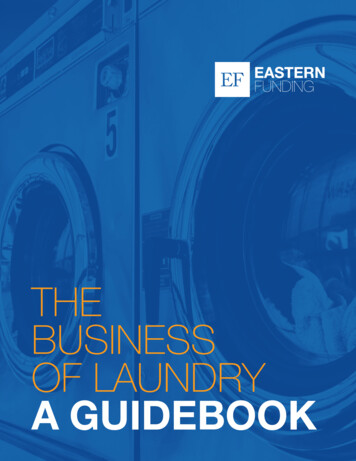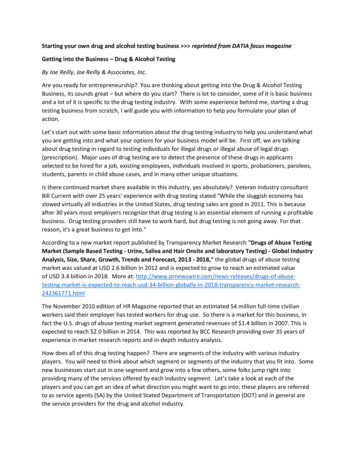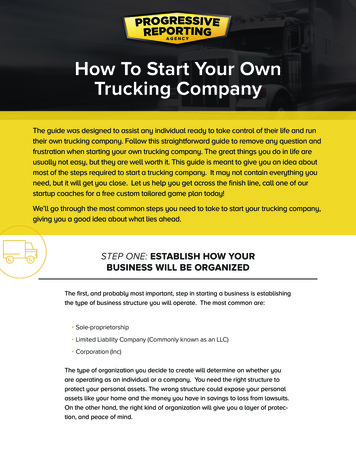
Transcription
How To Start Your OwnTrucking CompanyThe guide was designed to assist any individual ready to take control of their life and runtheir own trucking company. Follow this straightforward guide to remove any question andfrustration when starting your own trucking company. The great things you do in life areusually not easy, but they are well worth it. This guide is meant to give you an idea aboutmost of the steps required to start a trucking company. It may not contain everything youneed, but it will get you close. Let us help you get across the finish line, call one of ourstartup coaches for a free custom tailored game plan today!We’ll go through the most common steps you need to take to start your trucking company,giving you a good idea about what lies ahead.STEP ONE: ESTABLISH HOW YOURBUSINESS WILL BE ORGANIZEDThe first, and probably most important, step in starting a business is establishingthe type of business structure you will operate. The most common are: Sole-proprietorship Limited Liability Company (Commonly known as an LLC) Corporation (Inc)The type of organization you decide to create will determine on whether youare operating as an individual or a company. You need the right structure toprotect your personal assets. The wrong structure could expose your personalassets like your home and the money you have in savings to loss from lawsuits.On the other hand, the right kind of organization will give you a layer of protection, and peace of mind.
STEP TWO: DETERMINE THE TYPE OFTRUCKING BUSINESS YOU’LL RUNThere are many different types of trucking companies, the one you choose willusually depend on the type of goods you want to haul. People will typically focuson the area they either have experience with or have shipping or broker contactswho have loads you can haul. Here are some of the most common types. Reefer (Refrigerated Trailer) HAZMAT Dry Van Timber Flatbed/Lowbed Hotshots TankerSTEP THREE: OBTAIN REQUIREDFEDERAL AND STATE LICENSINGMost companies that operate a Commercial Vehicle over 10,000 lbs GVWR (Gross VehicleWeight Rating) will need to obtain a USDOT Number and/or Federal Operating Authority.Typically, if you travel through more than one state and are “For-Hire”, meaning you haulthe property of others, you will need both a USDOT Number and Operating Authority. If youtravel in only one state or you are not “For-Hire”, you usually only need a USDOT Number. Ifyou have to get Operating Authority, there is a 21 day vetting period all applicants must gothrough before the FMCSA (Federal Motor Carrier Administration) will activate your authority.These are not hard and fast rules, so you will want to talk to us and we’ll help you determinewhat is needed for your type of operation. There are other things to consider that arebeyond the scope of this guide. Here are some of them: Additional state permits required by states you plan to operate in The type of operating authority you need If you need a HAZMAT (Hazardous Materials) Permit BOC - 3 Filing UCR (Unified Carrier Registration)Each state can very in trucking rules and regulations, make sure to research your state’scommercial driver’s license requirements, rules and manuals, safety information, licensesand permits, taxes, and all other related items. For more information on the regulations thetrucking industry faces, download our Getting in Compliance with the Transportation SafetyRegulations guide. These regulations can be confusing and time-consuming, consider hiring acompliance professional to help make sure all of your requirements are met.
STEP FOUR: DETERMINE HOWYOUR BUSINESS WILL OPERATEThere are two common ways most trucking companies operate. They either hire employeedrivers or use leased owner-operators. There are pro’s and con’s of both methods, we’llcover some of them here. Keep in mind, some companies use both techniques and havesome employee drivers and some owner-operators.LEASED-OWNER OPERATORS:EMPLOYEE DRIVERS:You will run your business using sub-contractorsas your drivers, these drivers will bring their ownequipment. You will run the business and receivecontracts like a normal business owner but the driverswill not actually be employed by your company.You will privately run all of your operations,giving you full control of your business. Byrunning your company this way you will haveto use all of your own equipment, and hire afleet of private drivers as employees.PROSPROS Cuts down on start-up costs Total control over your business May cut down on insurance costs Total control over your employees Reduces required equipment Typically results in higher return on profits Owner-operators are usually more investedin the company’s successCONS Higher start-up costsCONS Higher operating costs Less control over your drivers Cuts into your profits Usually more headache working withemployees vs. owner-operatorsSTEP FIVE: BUY/LEASE THE PROPER EQUIPMENTIf you choose to operate your company using employee drivers, you will need to purchaseyour own vehicle(s). Your start up costs and budget will determine how many vehicles isreasonable and what type. Many businesses will start with a small fleet and increase in sizeas they become profitable. Explore your options depending on the type of trucking companyyou will run. Below are some options to consider based on need:NEWUSEDBUYLEASELow maintenance, lessdowntime, newest technology, lower operatingcosts, environmentallyfriendly. If you run a lotof miles and can affordto buy a new truck it ishighly recommended.If you aren’t runningmany miles a year thenused is a solid option.Lowest price point basically getting twofor one. Run the risk of issues due toage. Do your research and check withthe people who service and repair themto make sure you’re getting a truck that’sworth the value. If you go the used route,be cautious, you don’t want a truck that isgoing to blow an engine or transmissionor experience high repair costs duringthe first year. Major repairs during thetwo years of operation is one of the mostcommon reasons we see companies goout of business.Large motor carrierstend to have theexpertise to manageall aspects of vehicleownership. If interestrates are low, trade-inallowances are good,you have financingsources, and enoughmoney to cover thedown payment, buying is often a goodoption.There are many advantagesto leasing. Lower downpayments, you can typically expense the entiremonthly payment, and thelease usually ends beforemajor repairs are needed.Because leasing requiresless money, you typicallycan grow faster and havemore operating capital.
STEP FIVE: INSURANCEInsurance is one of the most important and costly pieces of your business. It is essential thatyou obtain your insurance from an agent who specializes in Trucking Insurance. Failure todo so can cause delays in our authority becoming active and not having adequate coveragein the event of an accident or issue with a load.We have seen too many companies go out of business because of insurance issues. Don’tbe one of them, be sure to understand your insurance responsibilities fully by discussingthem with a Commercial Vehicle Specialist. Keep in mind, if your drivers don’t have at leasttwo years of CDL insurance it can be hard for a new trucking company to obtain commercialvehicle insurance for companies that operate long-haul.Along with you insurance responsibilities, your employer responsibilities require you tocomply with health and safety standards and regulations. If you hire employees, your agentshould be able to tell you want you need to do regarding Worker’s Compensation Insurance.We have a handful of agents we can refer you to who deal specifically with truck insuranceSTEP SIX: MAKING SURE YOUR VEHICLES ARE COMPLIANTREGISTRATION/TAGS Registering your truck and trailer is a much more complicated andexpensive process than registering your car. You actually pay registration fees in every stateyou travel through or plan to travel through. Depending on your state, the Tax Commission,DMV or DOT typically handles vehicle registration.The two most common types of Commercial Vehicle registrations are Base Plating and IRP(International Registration Plan). If your commercial vehicle is going to stay in one state orrarely travel out of state you will probably Base Plate. Base plates are only good in thestate where it was issued. Typically, vehicles with a GVW over 26,000 lbs will also need toget a Special Fuel Use Permit as well.If your vehicle travels through more than one state, you will typically need to get IRPregistration. This type of registration allows you to take your commercial vehicle into everystate and Canadian province. If your vehicle(s) have a GVW over 26,000 lbs, you will probablyalso need an IFTA (International Fuel Tax Agreement) license as well.SAFETY INSPECTIONS Most commercial vehicles have to have an annual safety inspection.STATE REQUIREMENTS Some states have additional requirements for vehicles that passthrough them. For example, trucks and trailers that go into California must be CARB(California Air Resources Board) compliant.
STEP SEVEN: THE NEW ENTRANT AUDITWithin the first year of being in business, every new motor carrier is required by law to passwhat the FMCSA calls a new entrant audit. During the audit, someone from the FMCSA, orone of their state partners, will usually visit with you in person and conduct an audit to makesure you understand and are following the safety regulations. The audits usually last anywhere from 1-4 hours depending on how well prepared you are. They are looking to makesure you have a system in place to follow the regulations. Our Audit Assurance Packagehelps you develop that system so you pass the audit without any problems.STEP EIGHT: KEEP YOUR WHEELS TURNINGIn the trucking industry, if your wheels aren’t turning you aren’t making money. It is importantthat you have enough loads to keep you truck moving. Equally important, those loads mustbe profitable. You need to understand what your expense per mile is and how much profityou should make per mile so you know if loads you are looking at hauling will make youmoney. The last thing you want to do is take loads that you lose money on.The trucking industry is a competitive one, making it difficult to receive contracts. Starting outcan be a challenge, not every shipper or broker will work with a new trucking company, youwill have to build a positive reputation in order to gain good accounts. As time goes on moreand more doors will open and being profitable will become easier. There are three mainways most companies get loads: Directly from shippers (Most profitable) Through brokers Using load boardsIt is common for successful trucking companies to develop relationships with shippers intheir home town so they can get the best rates for loads that take them out of town. Thenthey will use brokers or load boards that typically pay less for the backhaul that gets themback home. As long as the combined rate of the two loads is good, you’ll come out a winner.That is a very simplistic example, but it gives you an idea for what many companies do.
Load boards typically have tools that tell you where the best rates are based on currentconditions. Over time you can use them to learn where to go to get the highest paying loadsbased on the time of year.Another big stumbling block is a lack of cashflow, especiallyearly on in the life of a trucking company. Most transportation companies don’t start collecting payments for the workthey do until 30 days or more after they completed thework. Most businesses don’t have enough cash on handto pay for their fuel and all the bills that come duebefore payments from their clients start comingin. We have financing solutions to helpbridge that gap and smooth outyour cash flow so you have themoney you need to operatewhen you need it.CONCLUSIONOwning your own trucking company is a challenge, but also very rewarding. It is agreat way to create the kind of income and lifestyle you want. Hopefully this guidehas given you a better idea about how to get from where you are today to rollingdown the road earning money that goes to no one else but you. If you have additionalquestions about the process, we are only a phone call away. Good Luck!7304 S 300 W, STE 201MIDVALE, UT 840471-866-736-6507INFO@PROGRESSIVEREPORTING.COM
You will run your business using sub-contractors as your drivers, these drivers will bring their own equipment. You will run the business and receive contracts like a normal business owner but the drivers will not actually be employed by your company. PROS Cuts down on start-up costs
